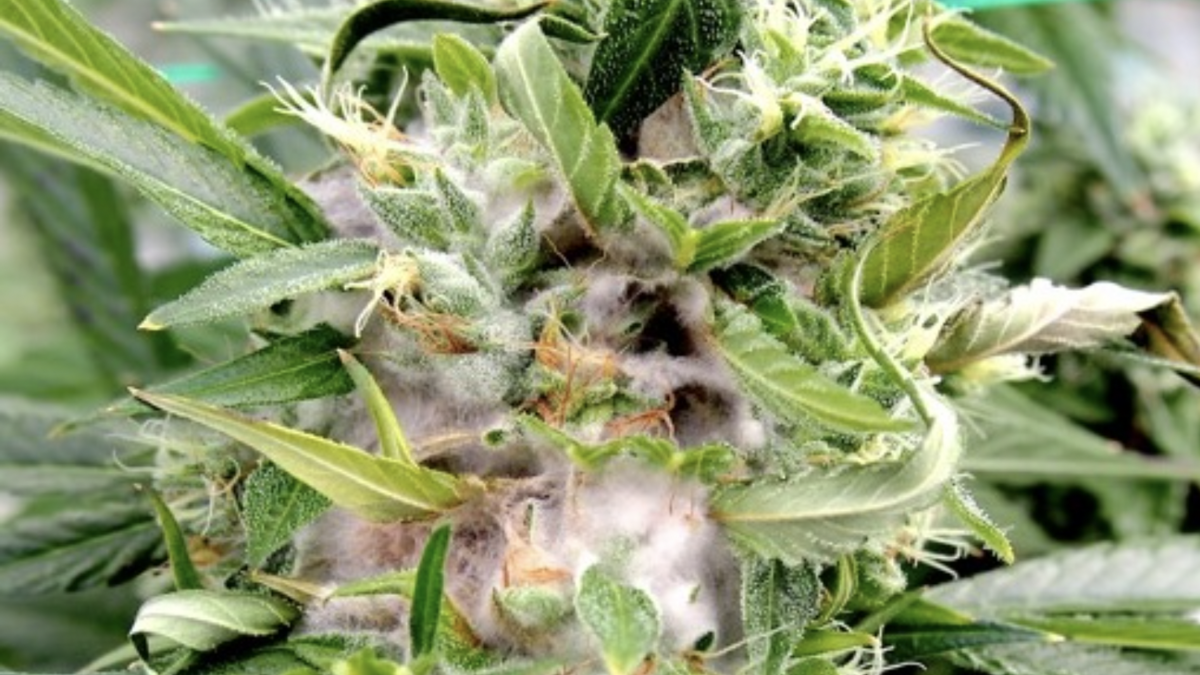Study finds fungi contaminants in cannabis pose potential health risks

Proliferation of mycelium of a Fusarium species within cannabis inflorescence tissues under conditions of high humidity. Photo from Frontiers in Microbiology, courtesy of study author Z. Punja
Cannabis use, even for medical purposes, could make some people sick due to harmful fungi that contaminate the plants.
That is the key finding of a recently published study, whose authors recommend further examination and consideration of changes to regulations to protect consumers, especially those who are immunocompromised.
The article was published in Frontiers in Microbiology, and included Arizona State University Assistant Professor Maxwell Leung and graduate student Ariell Stephens, both from the School of Mathematical and Natural Sciences at Arizona State University; Kimberly Gwinn, professor of entomology and plant pathology at the University of Tennessee Institute of Agriculture; and Zamir Punja, professor of plant pathology/biotechnology at Simon Fraser University, Burnaby, British Columbia, Canada.
They examined data, previous studies, and U.S. and international regulations related to the cannabis and hemp industry.
“Due to the illegal status of cannabis at the federal level in the United States, the contaminant regulation policies for cannabis and cannabis-related products fall under the jurisdiction of state agencies,” Leung said. “Paradoxically, in jurisdictions where cannabis is still considered illegal but is being sold, currently, there are no regulations to limit fungal contaminants in products.
While cannabis research has mostly focused on the substance and medical uses of the plant, with the increased legalization of cannabis for various uses, their findings address the need for studies of potential health risks.
“Hemp and cannabis are new crops, and we are in the early stages of understanding relationships with their pathogens,” Gwinn said.
Among the pathogens produced are fungal mycotoxins, which are compounds that can negatively impact human health and are regulated in other crops.
“In a recent study in Luxembourg, a mycotoxin (ochratoxin A, or OTA) was detected in one-third of 142 illicit cannabis samples,” Leung said.
But for legal cannabis, early studies have shown improved quality of product.
“In a second study conducted by my group, OTA was not detected in more than 9,000 flower and extract samples from approximately 300 legal cannabis producers and manufacturers for compliance testing in California during 2020 and 2021,” Leung said. “This study suggests that legalization of cannabis production may be having an intended consequence of improving quality with lower mold contamination, but additional studies are needed to confirm this.”
The authors examined fungi including Aspergillus, Penicillium, Fusarium, Mucor and others; reviewed the regulations and assessment methods of the contaminants; and offered recommendations to produce safer products for all consumers.
“Human health risk assessment methodologies used to regulate food and pharmaceuticals have yet to become standard for the emerging cannabis and hemp industries,” Gwinn said. “Additionally, the wide range of consumer uses of cannabis and hemp flowers, including for medical use by patients with susceptible conditions, makes it uniquely challenging to assess and manage human health risk of these contaminants.”
Environmental factors such as where the plants are grown, whether indoors or outdoors, and in soil or soilless media, may impact the kinds of contaminants and ensuing health risks.
Studies reviewed by the authors show some fungi may cause infection on lung and skin tissues, and these infections were most common when smoked and less common in edibles.
They also found cancer patients using cannabis to help with nausea and appetite as well as transplant patients and consumers with HIV and Type 1 diabetes may be particularly susceptible to infection. Studies also show workers harvesting cannabis could also be at risk. The scientists encourage consumers who are immunocompromised to use products that have been sterilized until better data are obtained.
Recreational use of hemp and cannabis is common in many areas, and all case studies linking cannabis use and fungal infections, except one, involved patients who were immunocompromised. The authors suggest a potential solution “to reduce potential harm to medical users of cannabis from toxigenic fungi is to develop a two-tier system that distinguishes products intended for medical and recreational use.”
“We wrote this article to bring these issues to the attention of the scientific, medical and regulatory communities,” Gwinn said. “We hope to encourage further research in this area, particularly in the areas of mycotoxins in product. Better data and public access to data will allow us to fully evaluate these risks and subsequently ensure safe products for consumers.”
Leung said, "These observations point to the need to harmonize the regulatory action levels for mycotoxin contaminants across all legalized jurisdictions for cannabis production. It also underlies the importance of supporting legal cannabis and hemp production systems where stringent regulations ensure a higher-quality product.”
More Science and technology
Large-scale study reveals true impact of ASU VR lab on science education
Students at Arizona State University love the Dreamscape Learn virtual reality biology experiences, and the intense engagement it…

ASU-led space telescope is ready to fly
The Star Planet Activity Research CubeSat, or SPARCS, a small space telescope that will monitor the flares and sunspot activity…

ASU at the heart of the state's revitalized microelectronics industry
A stronger local economy, more reliable technology, and a future where our computers and devices do the impossible: that’s the…

